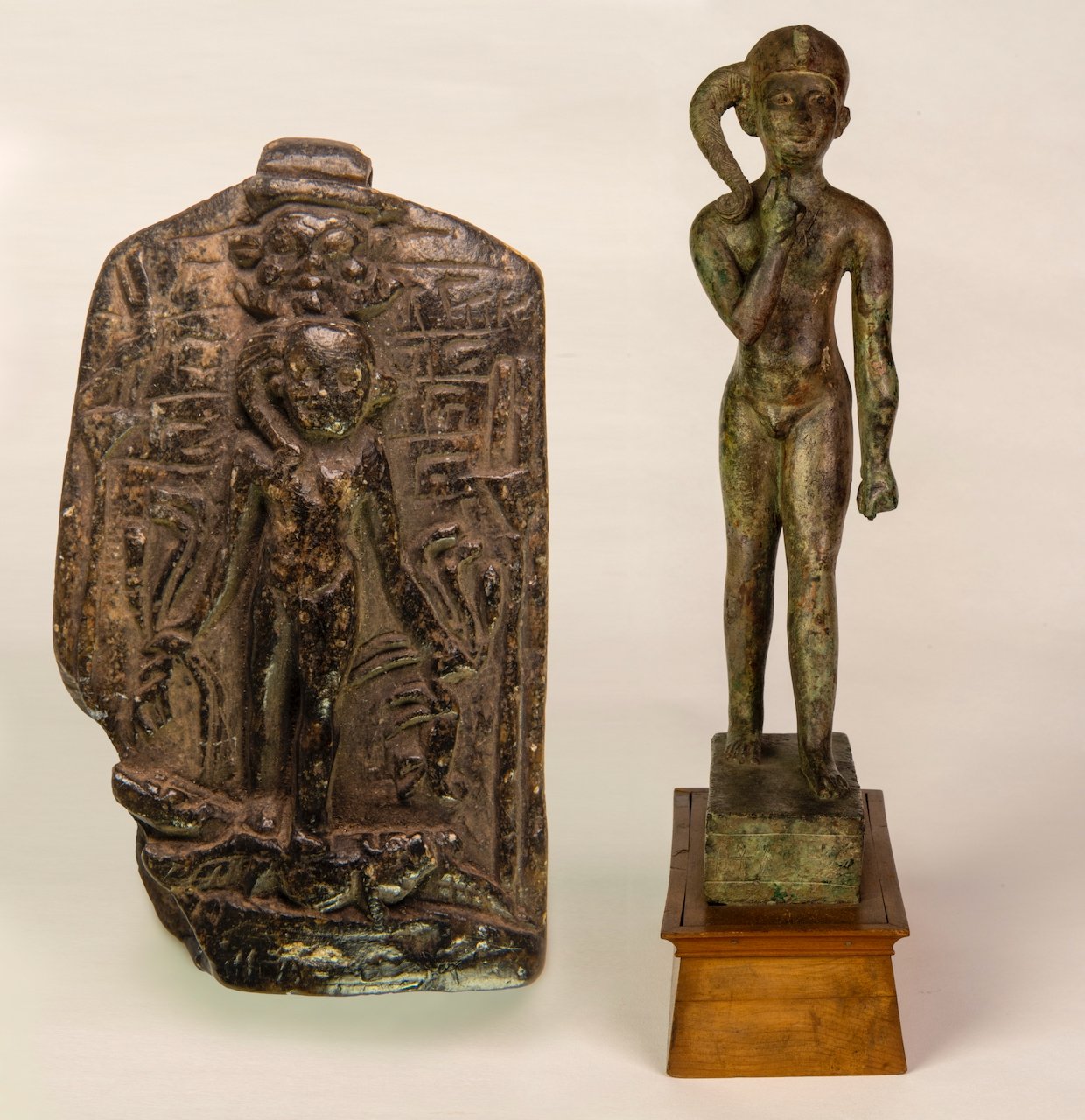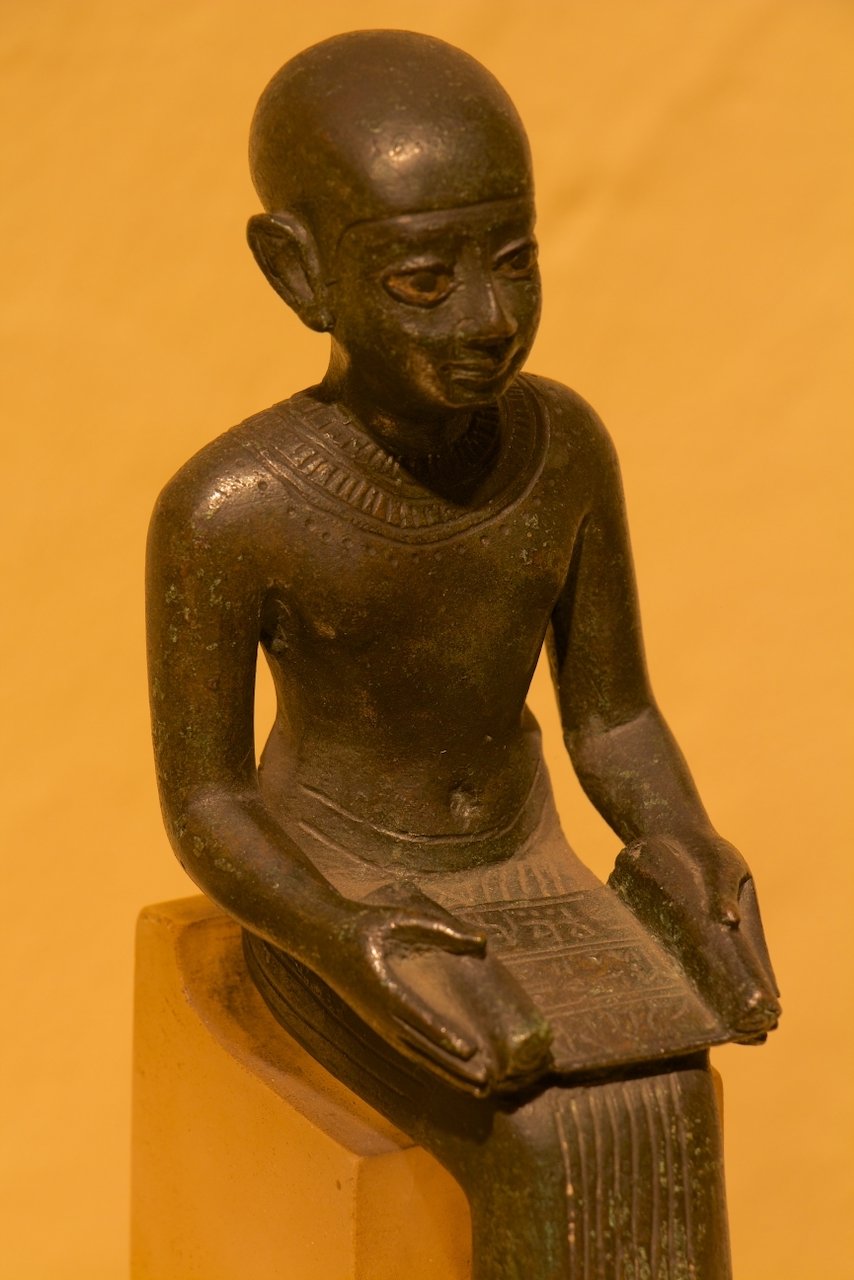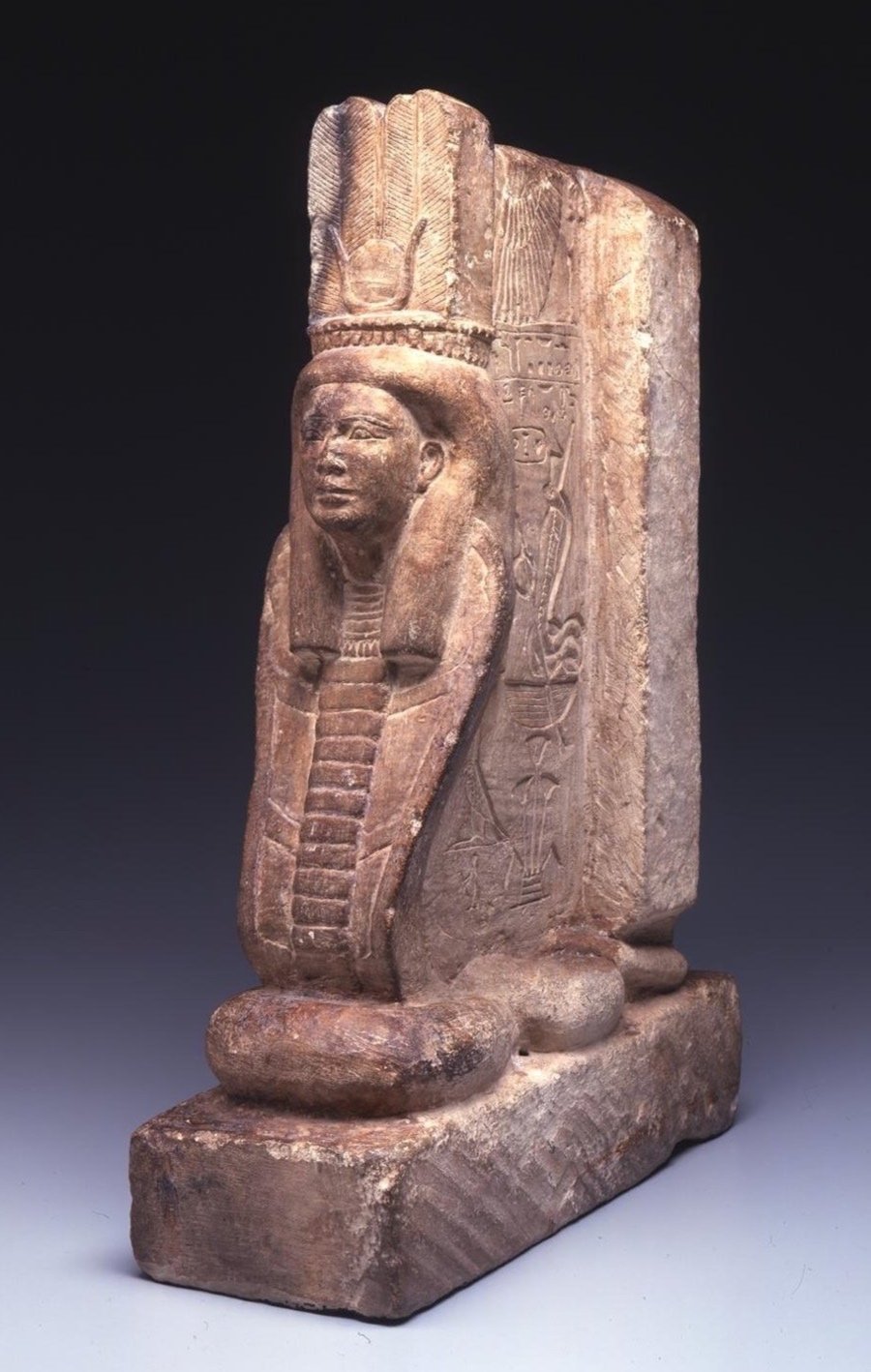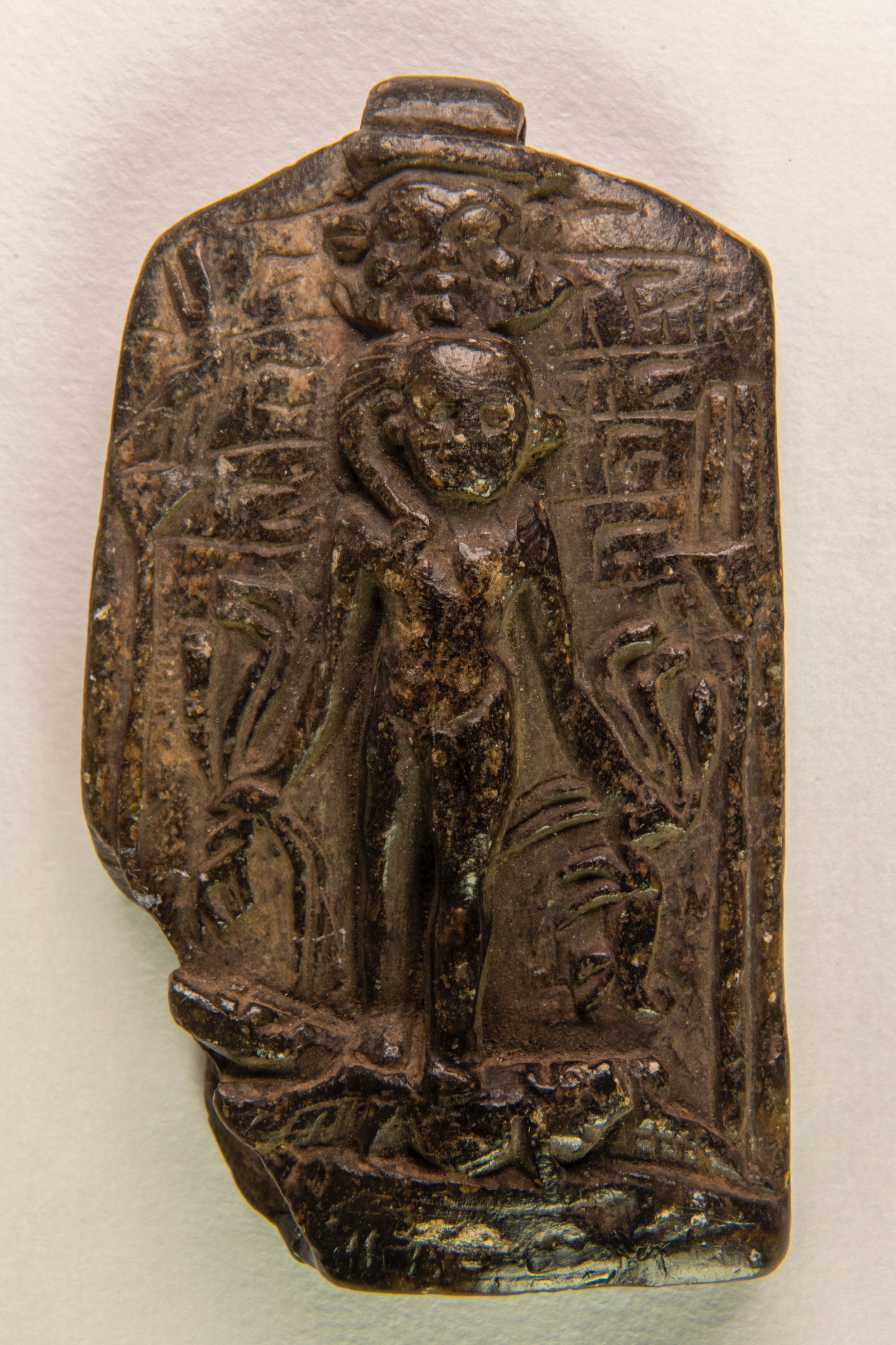Glencairn Museum News | Number 4, 2022
Two related objects from the Egyptian collection at Glencairn Museum. Left: A soapstone amulet depicting Horus on the Crocodiles, also called a Cippus of Horus (E427). Left: A bronze statuette of Harpocrates (E1166). Both objects depict the god Horus the Child (Hor-pa-khered in Egyptian, or Harpocrates in Greek).
Medicine was a well-established science in ancient Egypt. Written evidence for medical treatments in Egypt appears as early as the Middle Kingdom (c. 1800 BCE) in a manuscript known as the Kahun Papyrus, Egypt’s oldest medical text (Figure 1). The subject of the papyrus concerns women’s health issues. However, medical practices in Egypt date much earlier than the preserved texts. According to the historian Manetho (3rd century BCE), the second king of the First Dynasty had an interest in medicine. Manetho’s original history of Egypt, the Aegyptiaca, is lost, but parts of this work are preserved in the writings of later ancient historians such as Eusebius of Caesarea, who wrote concerning this king, “Athothis . . . held the throne for 27 years. He built for himself a royal palace at Memphis, and also practiced the art of medicine, writing books on the method of anatomy.”
Figure 1: A number of medical texts are known from ancient Egypt. The earliest is the Kahun Medical Text, which contains medical treatments for gynecological cases. Image courtesy of the Petrie Museum of Egyptian Archaeology, UC 32057.
Figure 2: The word swnw, meaning “doctor,” in hieroglyphs.
As early as the Old Kingdom (2700–2200 BCE), the medical profession in Egypt was highly organized, with physicians having several ranks and specializations. The word for an ordinary doctor was swnw (Figure 2). Throughout pharaonic history, there are approximately 100 doctors whose names are known. Surgical implements such as scalpels, forceps, and probes were known in ancient Egypt, and some of these instruments are depicted on the rear wall of the temple of Kom Ombo (Figure 3). Egyptian doctors identified the difference between sterile and infected wounds and were aware of the importance of taking the pulse. From the New Kingdom (1536–1075 BCE) on, Egyptian doctors were found as advisors of chief physicians in foreign courts in Anatolia, Syria, and Mesopotamia. The Egyptian pharmacopeia was vast and included ingredients such as opium, castor oil, and honey, as well as less orthodox ingredients such as bile, urine, and excrement.
Figure 3: A relief depicting a series of medical implements can be seen on the wall of the Kom Ombo temple. Image courtesy of Ad Meskens / Wikimedia Commons.
Figure 4: Bronze statuette of Imhotep. In the Glencairn Museum collection, E1163.
The best-known ancient Egyptian physician is Imhotep, the vizier and architect of King Djoser of the Third Dynasty (c. 2600 BCE). In subsequent dynasties, Imhotep was deified and worshipped as a wise man and healer (Figure 4). He later became identified with Asklepios, the Greek god of medicine and healing. Unlike the Greeks, the Egyptians did not have one sole god of medicine. Many deities played a role in health and healing. Each medical specialization had a particular god or goddess attached to it, and the human body was likewise divided into different parts, with a specific deity acting as guardian of each part.
A large number of medico-magical practices concern the bite of a scorpion, snake, or other dangerous creature. The species most dangerous to humans are found in deserts and semi-arid regions. Although they can thrive in desert climates, their habitats include areas where fresh water is available, such as villages on the floodplain adjacent to the desert. In Egypt today, there are at least two species of scorpions that are listed as being “medically important,” that is, dangerous to humans. The historian Pliny (23–79 CE) remarked that the area around Coptos was famous for its large scorpions, which administered fatal stings.
Some mummy labels record deaths from the bite of a scorpion, for example, “Aurelius Ammonius was carried off, struck by a scorpion,” and “Cleopatra, daughter of Moneon . . . who has perished ingloriously and indiscriminately by a violent death . . . for stung by a scorpion in the sanctuary of Thripis by the hill on the tenth day of Thoth . . . she perished on the 11th.” From this latter example, we can see that the bite of a scorpion did not inflict instant death.
Similarly, poisonous snakes were an ever-present danger. Several species of deadly snakes existed in ancient Egypt, including the cobra and the horned viper. One of the most famous snake bites in history comes to us in the stories surrounding the death of the last ruler of pharaonic Egypt, Cleopatra VII. Faced with capture by the Romans, Cleopatra opted to take her own life. While the method she chose is often debated, countless artists who have depicted the moment of her death opted to include a poisonous snake in the scene (Figure 5).
Figure 5: Engraving depicting the death of Cleopatra by Agostino Veneziano (1528 CE). Image courtesy of the Metropolitan Museum of Art, 49.97.75.
Figure 6: Limestone statue of a female serpent deity. The goddess has the body of a cobra and a human head. She wears a plumed headdress with a sun disk and horns. This may be a representation of the goddess Renenutet. Image courtesy of Penn Museum, 57-18-1.
In addition to their appearance in the natural world, snakes and scorpions held a variety of roles in Egyptian mythology and iconography. In some instances, these creatures had a positive and protective role. At other times they represented evil or dangerous forces. One of the most recognizable uses of snake iconography in Egypt is the appearance of the rearing cobra, or uraeus, seen on the brow of the Egyptian pharaoh. The uraeus, which symbolized the power of the king, represented the goddess Wadjet, the protector of Lower Egypt. Several other deities could take the form of a snake or a human-headed snake. The cobra deity Renenutet was a goddess of fertility and the harvest (Figure 6). Meretseger was the divine serpent who protected the area in Thebes where the Valley of the Kings is located. An example of a dangerous snake in Egyptian mythology is the demon Apep. The enemy of Re, the sun god, Apep took the form of a great serpent who tried to kill Re each night. Religious texts and images describe ways in which Apep was killed before he could succeed in harming the sun god. In some examples, the god Seth is shown stabbing Apep with a spear. In other examples, the sun god himself takes the form of a large cat and is depicted killing the Apep serpent with a large knife (Figure 7).
Similarly, the deadly scorpion could also have a positive meaning to the ancient Egyptians. Representations of this creature appear early in Egyptian art; in fact, two of Egypt’s earliest rulers bore the name “Scorpion.” The goddess Selket was usually shown as a woman with a headdress in the form of a scorpion (Figure 8). Selket’s role was as a protector. Together with Isis, Nephthys, and Neith, she guarded the internal organs of the deceased in the tomb. In some traditions she is the mother of Qebehsenuef, one of the four sons of Horus whose head decorated the top of the canopic jar that contained the intestines. She also helped protect against the bite of venomous creatures.
Figure 7: Painting of a scene from the tomb of Sennedjem by Charles K. Wilkinson showing the sun god in the form of a large cat killing the serpent Apep. Image courtesy of Metropolitan Museum of Art, 30.4.1.
Figure 8: Basalt statue of a goddess with a scorpion emblem atop her head. Image courtesy of the British Museum, EA57365.
Figure 9: Faience figure of Isis nursing her son Horus. In the Glencairn Museum collection, E139.
Due to the ever-present threat of these dangerous creatures, magical spells against scorpion bites are numerous, and many are based on mythological events. The words of these spells address the poison of the scorpion directly: the poison is told to move, either to retreat or to come out. Some of the spells include a story about the god Horus being stung by a scorpion. Horus is the son of Isis and Osiris. He was conceived after the death of his father at the hands of his jealous uncle, Seth. During his youth, Horus and his mother went into hiding in the marshes of the Nile Delta, far from the eyes of Seth. We learn that during this time, Horus was fatally stung by a scorpion. Isis found his body and appealed tearfully to the god Thoth to save him (Figure 9). Thoth responded by invoking magical powers to bring Horus back to life, and giving him the power to trample dangerous creatures. This story, and others like it, came to be incorporated into magical spells as conjurations against the bite of a scorpion. In spells of this type, the god Horus is always the suffering victim, and the human patient is identified with him. The hope was that, just as Horus was cured of his dangerous bite, so too would the human patient be healed of their ailment.
At the end of the New Kingdom (1536–1075 BCE), a new type of healing implement arrives, the healing statue or stela. Designed for protection against (or cures for) scorpion stings and snake bites, this type of object is known as a Horus on the Crocodiles stela, or a Cippus of Horus. Stelae like these, including a soapstone example in the Glencairn Museum collection, feature a representation of the god Horus on the front (Figure 10–11). This depiction of Horus as a young child, wearing a hairstyle known as the sidelock of youth, is known as Horus the Child (Hor-pa-khered in Egyptian, or Harpocrates in Greek; see Figures 12–14). These stelae typically show a naked, youthful Horus standing atop two or more crocodiles. The young god also grasps snakes, scorpions, and dangerous desert creatures such as lions and oryxes. As with other healing spells, Horus was the prototype of the suffering patient. Along with his power of being cured from a bite, he can also trample crocodiles, snakes, and other creatures, and seal their mouths against biting.
Figure 10: Front view of a Horus on the Crocodiles amulet. In the Glencairn Museum collection, E427.
Figure 11: Drawing of a Horus on the Crocodiles amulet in the Glencairn Museum collection, E427 (see Figure 10). Drawing courtesy of Jennifer Houser Wegner.
Figure 12: Bronze statuette of Harpocrates. In the Glencairn Museum collection, E1166.
Figure 13: Relief with an image of the child-god Harpocrates. In the Glencairn Museum collection, E1123.
Figure 14: Amulet of Horus the Child flanked by his mother, Isis, and his aunt, the goddess Nephthys. In the Glencairn Museum collection, E163.
Similar imagery is found in depictions of the Egyptian god Shed, whose name means “the Savior.” Closely associated with Horus the Child, Shed was a protective deity whom people could approach to ask for help with various problems. Like Horus the Child, Shed is usually shown wearing the sidelock of youth. He grasps wild animals in his hands, and exerts his control over their chaotic and dangerous natures. Sometimes he appears in a chariot drawn by horses or griffins (Figure 15).
Figure 15: Scene of the god Shed riding in a chariot pulled by a team of griffins. He shoots arrows at fleeing dangerous creatures. Image courtesy of Penn Museum, E12514.
In addition to the central representation of young Horus, other divine imagery can decorate these stelae (Figure 16). A representation of a papyrus-topped standard appears on Horus’s proper right; a figure of a falcon, representing the god Horus of Behedet, rests atop the papyrus blossom. The falcon wears a tall, double-plumed headdress. On the proper left of Horus is another column topped by the emblem of Nefertem, the Protector of the Two Lands.
Figure 16: Horus on the Crocodiles or Cippus of Horus stela. Image courtesy of Metropolitan Museum of Art, 44.4.53.
Figure 17: Faience amulet of the god Bes. Image courtesy of Penn Museum, 31-27-258.
Frequently the head of the god Bes appears at the top of the stela, in the center. Bes was a protector of the house and home (Figure 17). He was usually shown as a figure of small stature. His bearded face can be leonine in form, and he was often shown grimacing, with his tongue sticking out. This somewhat fearsome appearance was meant to scare away evil forces. He usually wears a distinctive feathered headdress, and often holds knives to ward off dangerous creatures. Images of Bes frequently decorated household goods such as beds and headrests (see Glencairn Museum News, No. 7, 2018: “Headrests in Glencairn’s Egyptian Collection: Practicality and Protection”).
Another magical tactic for dealing with dangerous entities is trampling, a practice that can be seen in the posture of Horus on these healing stelae. The young god is shown standing atop a collection of two or more crocodiles. He controls these dangerous animals by grasping them in his hands and rendering them inert, and by crushing the crocodiles that appear under his feet. Other examples of this magical practice can be seen with a pair of decorated sandals from the tomb of Tutankhamun, where the soles of the king’s shoes are decorated with images of enemies of Egypt. Magically or symbolically, the king would crush these enemies with each one of his footsteps. We also see this practice applied in the funerary realm, in examples of foot-cases covering the feet of Egyptian mummies. Often figures of scorpions (or bound enemy captives) decorate the bottom of these coverings. This would enable the deceased to eternally trample these dangerous beings (Figure 18).
Figure 18: Fragment of a painted cartonnage foot-covering decorated with images of scorpions. Image courtesy of Penn Museum, E16209.
Figure 19: The back of the Horus on the Crocodiles amulet showing illegible incised text. In the Glencairn Museum collection, E427.
The surface of these stelae was often covered with magical spells on both the front and back. However, it was not necessary to be able to read the texts in order to use this magical apparatus. In many examples, including the example in the Glencairn Museum collection, the hieroglyphic text is not legible (Figure 19). The incised text is made to look like hieroglyphs, but it is gibberish. However, this lack of legibility would not have affected how this cippus would work. Literacy was quite low in ancient Egypt, and most people would not have been able to read the texts anyway. The appearance of the images on the stela, and the appearance of magical writing, would have been enough to make this magical object effective. Mere possession of the magical texts and images resulted in protection.
These stelae found popularity with all levels of society. They could be adapted to various situations, from large-scale examples that would be set up near temples (Figure 20), to small-scale versions that could be worn like an amulet around the neck. The small size of the Glencairn example makes it likely that it was used as an amulet. Larger-scale healing stelae were often mounted atop a basin and water was poured over the surface (Figure 21). Smaller examples may have been dipped in liquid. The power of the words and images was absorbed in the water and this liquid became magically charged. Then the water was used to heal or protect the patient who, after drinking it or pouring it on his body, would be cured just as Horus had been healed.
Figure 20: The largest and best-preserved example of a Cippus of Horus is the Metternich Stela. It dates to the Thirtieth Dynasty (360–343 BCE) and was commissioned by a priest named Esatum. It stood in the public part of a temple. Image courtesy of the Metropolitan Museum of Art, 50.85.
Figure 21: The healing statue of Djedhor in the Egyptian Museum, Cairo, JE 46431. Note the recessed basin on the base in front of the seated figure. Image courtesy of Onceinawhile, wikimedia.org.
We can see another example of ingesting water infused with magical words in the Demotic tale of Setne Khaemwas I. In this story, a man named Naneferkaptah has learned about the location of a secret magical book owned by the god Thoth. Spells contained in this book enable the reciter of the spells to be able to enchant the sky and the earth and to experience other divine phenomena. Naneferkaptah steals this book from its hiding place and brings it back and shares the information contained in it with his wife, Ihweret. Narrating the story, she tells us,
“I said to Naneferkaptah: [‘Welcome back! Let me] see this book for which we have taken these [great] pains!’ He put the book into my hand. I recited one spell from it; I charmed the sky, the earth, the netherworld, the mountains, the waters. I discovered what all the birds of the sky and the fish of the deep and the beasts were saying. I recited another spell; I saw Pre appearing in the sky with his Ennead. I saw the Moon rising, and all the stars of the sky in their forms. I saw the fish of the deep, though there were twenty-one divine cubits of water over them.”
Naneferkaptah ensured that this magical knowledge would remain with him by making a copy of the book and then dissolving the ink in liquid and drinking it: “he had a sheet of new papyrus brought to him. He wrote on it every word that was in the book before him. He soaked it in beer, he dissolved it in water. When he knew it had dissolved, he drank it and knew what had been in it.” Interestingly, in other texts, the word for “to swallow” is used as an expression meaning “to know,” so by ingesting this liquid that has been infused with magical words, this magic becomes known by, and active within, an individual. This was precisely the same way in which the magical healing stelae worked.
An intriguing holdover of some of these ancient Egyptian practices can be seen on a Byzantine period magical gem with Christian and Gnostic texts and imagery (Figures 22-23). An image of a naked four-winged being with a halo who stands atop two crocodiles appears on one side of this incised gem. Like Horus on the healing cippi, this figure grasps scorpions in his hands and tramples crocodiles under his feet. It is remarkable to see this traditional “pagan” iconography of Horus used here in an otherwise Christian context. While some have identified this figure as Christ, the text below the figure seems to state that it is an individual named Sisinnius who is the one trampling the crocodiles. Saint Sisinnius is well-known from other magical amulets from the Byzantine Period, where he is said to drive off demons who threaten pregnant women and children.
Figure 22: Reverse of amulet featuring a winged male figure at the top with crocodiles at his feet, surrounded by magic symbols. Image courtesy of the British Museum, 1938, 1010.1. Electrotype replica of a Byzantine original.
Figure 23: Obverse of Figure 22, featuring four rows of New Testament imagery and inscriptions. Image courtesy of the British Museum, 1938, 1010.1. Electrotype replica of a Byzantine original.
The ancient Egyptians relied on medical treatments for their various illnesses and injuries, but this was not their only path to healing. Magic permeated all aspects of life in ancient Egypt and it was regarded as an exact science. Magic and medicine were seen as equals; both were legitimate methods through which an illness could be cured. Every ailment might be the result of a hostile force, an enemy, a jealous dead person, or a disapproving god. It might be assumed that the type of affliction dictated the method of treatment, and that illnesses of unknown origin or hopeless curability might be treated with magical means, while ones with obvious causes (such as broken bones) would be treated with medicine. But it is more likely that the two methods were used simultaneously to effect a cure.
Jennifer Houser Wegner, PhD
Associate Curator, Egyptian Section, Penn Museum
University of Pennsylvania
A complete archive of past issues of Glencairn Museum News is available online here.
























